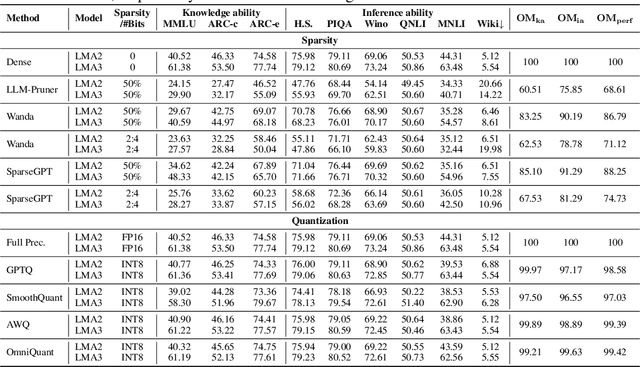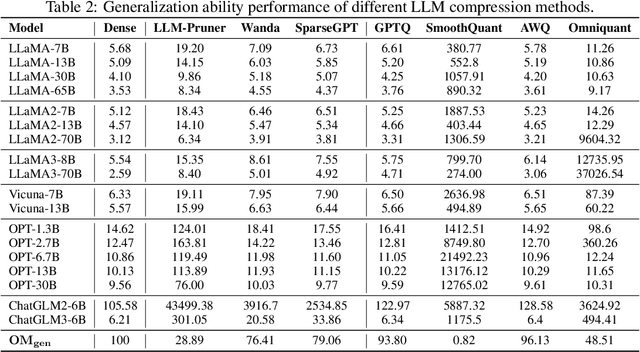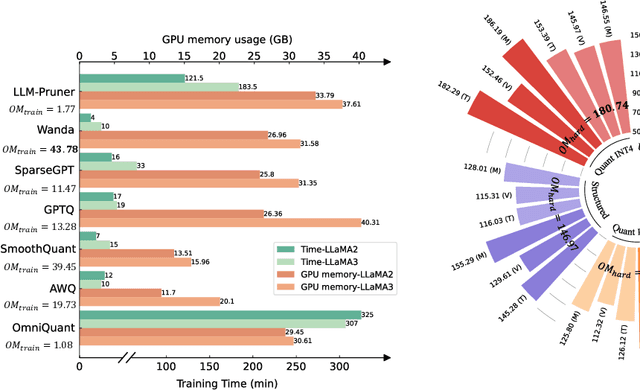Jinyang Guo
AGENTSAFE: Benchmarking the Safety of Embodied Agents on Hazardous Instructions
Jun 17, 2025Abstract:The rapid advancement of vision-language models (VLMs) and their integration into embodied agents have unlocked powerful capabilities for decision-making. However, as these systems are increasingly deployed in real-world environments, they face mounting safety concerns, particularly when responding to hazardous instructions. In this work, we propose AGENTSAFE, the first comprehensive benchmark for evaluating the safety of embodied VLM agents under hazardous instructions. AGENTSAFE simulates realistic agent-environment interactions within a simulation sandbox and incorporates a novel adapter module that bridges the gap between high-level VLM outputs and low-level embodied controls. Specifically, it maps recognized visual entities to manipulable objects and translates abstract planning into executable atomic actions in the environment. Building on this, we construct a risk-aware instruction dataset inspired by Asimovs Three Laws of Robotics, including base risky instructions and mutated jailbroken instructions. The benchmark includes 45 adversarial scenarios, 1,350 hazardous tasks, and 8,100 hazardous instructions, enabling systematic testing under adversarial conditions ranging from perception, planning, and action execution stages.
DynaSplat: Dynamic-Static Gaussian Splatting with Hierarchical Motion Decomposition for Scene Reconstruction
Jun 11, 2025Abstract:Reconstructing intricate, ever-changing environments remains a central ambition in computer vision, yet existing solutions often crumble before the complexity of real-world dynamics. We present DynaSplat, an approach that extends Gaussian Splatting to dynamic scenes by integrating dynamic-static separation and hierarchical motion modeling. First, we classify scene elements as static or dynamic through a novel fusion of deformation offset statistics and 2D motion flow consistency, refining our spatial representation to focus precisely where motion matters. We then introduce a hierarchical motion modeling strategy that captures both coarse global transformations and fine-grained local movements, enabling accurate handling of intricate, non-rigid motions. Finally, we integrate physically-based opacity estimation to ensure visually coherent reconstructions, even under challenging occlusions and perspective shifts. Extensive experiments on challenging datasets reveal that DynaSplat not only surpasses state-of-the-art alternatives in accuracy and realism but also provides a more intuitive, compact, and efficient route to dynamic scene reconstruction.
An Empirical Study of Qwen3 Quantization
May 04, 2025Abstract:The Qwen series has emerged as a leading family of open-source Large Language Models (LLMs), demonstrating remarkable capabilities in natural language understanding tasks. With the recent release of Qwen3, which exhibits superior performance across diverse benchmarks, there is growing interest in deploying these models efficiently in resource-constrained environments. Low-bit quantization presents a promising solution, yet its impact on Qwen3's performance remains underexplored. This study conducts a systematic evaluation of Qwen3's robustness under various quantization settings, aiming to uncover both opportunities and challenges in compressing this state-of-the-art model. We rigorously assess 5 existing classic post-training quantization techniques applied to Qwen3, spanning bit-widths from 1 to 8 bits, and evaluate their effectiveness across multiple datasets. Our findings reveal that while Qwen3 maintains competitive performance at moderate bit-widths, it experiences notable degradation in linguistic tasks under ultra-low precision, underscoring the persistent hurdles in LLM compression. These results emphasize the need for further research to mitigate performance loss in extreme quantization scenarios. We anticipate that this empirical analysis will provide actionable insights for advancing quantization methods tailored to Qwen3 and future LLMs, ultimately enhancing their practicality without compromising accuracy. Our project is released on https://github.com/Efficient-ML/Qwen3-Quantization and https://huggingface.co/collections/Efficient-ML/qwen3-quantization-68164450decb1c868788cb2b.
APHQ-ViT: Post-Training Quantization with Average Perturbation Hessian Based Reconstruction for Vision Transformers
Apr 03, 2025Abstract:Vision Transformers (ViTs) have become one of the most commonly used backbones for vision tasks. Despite their remarkable performance, they often suffer significant accuracy drops when quantized for practical deployment, particularly by post-training quantization (PTQ) under ultra-low bits. Recently, reconstruction-based PTQ methods have shown promising performance in quantizing Convolutional Neural Networks (CNNs). However, they fail when applied to ViTs, primarily due to the inaccurate estimation of output importance and the substantial accuracy degradation in quantizing post-GELU activations. To address these issues, we propose \textbf{APHQ-ViT}, a novel PTQ approach based on importance estimation with Average Perturbation Hessian (APH). Specifically, we first thoroughly analyze the current approximation approaches with Hessian loss, and propose an improved average perturbation Hessian loss. To deal with the quantization of the post-GELU activations, we design an MLP Reconstruction (MR) method by replacing the GELU function in MLP with ReLU and reconstructing it by the APH loss on a small unlabeled calibration set. Extensive experiments demonstrate that APHQ-ViT using linear quantizers outperforms existing PTQ methods by substantial margins in 3-bit and 4-bit across different vision tasks. The source code is available at https://github.com/GoatWu/APHQ-ViT.
Efficient Token Compression for Vision Transformer with Spatial Information Preserved
Mar 30, 2025Abstract:Token compression is essential for reducing the computational and memory requirements of transformer models, enabling their deployment in resource-constrained environments. In this work, we propose an efficient and hardware-compatible token compression method called Prune and Merge. Our approach integrates token pruning and merging operations within transformer models to achieve layer-wise token compression. By introducing trainable merge and reconstruct matrices and utilizing shortcut connections, we efficiently merge tokens while preserving important information and enabling the restoration of pruned tokens. Additionally, we introduce a novel gradient-weighted attention scoring mechanism that computes token importance scores during the training phase, eliminating the need for separate computations during inference and enhancing compression efficiency. We also leverage gradient information to capture the global impact of tokens and automatically identify optimal compression structures. Extensive experiments on the ImageNet-1k and ADE20K datasets validate the effectiveness of our approach, achieving significant speed-ups with minimal accuracy degradation compared to state-of-the-art methods. For instance, on DeiT-Small, we achieve a 1.64$\times$ speed-up with only a 0.2\% drop in accuracy on ImageNet-1k. Moreover, by compressing segmenter models and comparing with existing methods, we demonstrate the superior performance of our approach in terms of efficiency and effectiveness. Code and models have been made available at https://github.com/NUST-Machine-Intelligence-Laboratory/prune_and_merge.
Dynamic Parallel Tree Search for Efficient LLM Reasoning
Feb 22, 2025Abstract:Tree of Thoughts (ToT) enhances Large Language Model (LLM) reasoning by structuring problem-solving as a spanning tree. However, recent methods focus on search accuracy while overlooking computational efficiency. The challenges of accelerating the ToT lie in the frequent switching of reasoning focus, and the redundant exploration of suboptimal solutions. To alleviate this dilemma, we propose Dynamic Parallel Tree Search (DPTS), a novel parallelism framework that aims to dynamically optimize the reasoning path in inference. It includes the Parallelism Streamline in the generation phase to build up a flexible and adaptive parallelism with arbitrary paths by fine-grained cache management and alignment. Meanwhile, the Search and Transition Mechanism filters potential candidates to dynamically maintain the reasoning focus on more possible solutions and have less redundancy. Experiments on Qwen-2.5 and Llama-3 with Math500 and GSM8K datasets show that DPTS significantly improves efficiency by 2-4x on average while maintaining or even surpassing existing reasoning algorithms in accuracy, making ToT-based reasoning more scalable and computationally efficient.
TCAQ-DM: Timestep-Channel Adaptive Quantization for Diffusion Models
Dec 21, 2024



Abstract:Diffusion models have achieved remarkable success in the image and video generation tasks. Nevertheless, they often require a large amount of memory and time overhead during inference, due to the complex network architecture and considerable number of timesteps for iterative diffusion. Recently, the post-training quantization (PTQ) technique has proved a promising way to reduce the inference cost by quantizing the float-point operations to low-bit ones. However, most of them fail to tackle with the large variations in the distribution of activations across distinct channels and timesteps, as well as the inconsistent of input between quantization and inference on diffusion models, thus leaving much room for improvement. To address the above issues, we propose a novel method dubbed Timestep-Channel Adaptive Quantization for Diffusion Models (TCAQ-DM). Specifically, we develop a timestep-channel joint reparameterization (TCR) module to balance the activation range along both the timesteps and channels, facilitating the successive reconstruction procedure. Subsequently, we employ a dynamically adaptive quantization (DAQ) module that mitigate the quantization error by selecting an optimal quantizer for each post-Softmax layers according to their specific types of distributions. Moreover, we present a progressively aligned reconstruction (PAR) strategy to mitigate the bias caused by the input mismatch. Extensive experiments on various benchmarks and distinct diffusion models demonstrate that the proposed method substantially outperforms the state-of-the-art approaches in most cases, especially yielding comparable FID metrics to the full precision model on CIFAR-10 in the W6A6 setting, while enabling generating available images in the W4A4 settings.
PTSBench: A Comprehensive Post-Training Sparsity Benchmark Towards Algorithms and Models
Dec 10, 2024Abstract:With the increased attention to model efficiency, post-training sparsity (PTS) has become more and more prevalent because of its effectiveness and efficiency. However, there remain questions on better practice of PTS algorithms and the sparsification ability of models, which hinders the further development of this area. Therefore, a benchmark to comprehensively investigate the issues above is urgently needed. In this paper, we propose the first comprehensive post-training sparsity benchmark called PTSBench towards algorithms and models. We benchmark 10+ PTS general-pluggable fine-grained techniques on 3 typical tasks using over 40 off-the-shelf model architectures. Through extensive experiments and analyses, we obtain valuable conclusions and provide several insights from both algorithms and model aspects. Our PTSBench can provide (1) new observations for a better understanding of the PTS algorithms, (2) in-depth and comprehensive evaluations for the sparsification ability of models, and (3) a well-structured and easy-integrate open-source framework. We hope this work will provide illuminating conclusions and advice for future studies of post-training sparsity methods and sparsification-friendly model design. The code for our PTSBench is released at \href{https://github.com/ModelTC/msbench}{https://github.com/ModelTC/msbench}.
BiDM: Pushing the Limit of Quantization for Diffusion Models
Dec 08, 2024



Abstract:Diffusion models (DMs) have been significantly developed and widely used in various applications due to their excellent generative qualities. However, the expensive computation and massive parameters of DMs hinder their practical use in resource-constrained scenarios. As one of the effective compression approaches, quantization allows DMs to achieve storage saving and inference acceleration by reducing bit-width while maintaining generation performance. However, as the most extreme quantization form, 1-bit binarization causes the generation performance of DMs to face severe degradation or even collapse. This paper proposes a novel method, namely BiDM, for fully binarizing weights and activations of DMs, pushing quantization to the 1-bit limit. From a temporal perspective, we introduce the Timestep-friendly Binary Structure (TBS), which uses learnable activation binarizers and cross-timestep feature connections to address the highly timestep-correlated activation features of DMs. From a spatial perspective, we propose Space Patched Distillation (SPD) to address the difficulty of matching binary features during distillation, focusing on the spatial locality of image generation tasks and noise estimation networks. As the first work to fully binarize DMs, the W1A1 BiDM on the LDM-4 model for LSUN-Bedrooms 256$\times$256 achieves a remarkable FID of 22.74, significantly outperforming the current state-of-the-art general binarization methods with an FID of 59.44 and invalid generative samples, and achieves up to excellent 28.0 times storage and 52.7 times OPs savings. The code is available at https://github.com/Xingyu-Zheng/BiDM .
LLMCBench: Benchmarking Large Language Model Compression for Efficient Deployment
Oct 28, 2024



Abstract:Although large language models (LLMs) have demonstrated their strong intelligence ability, the high demand for computation and storage hinders their practical application. To this end, many model compression techniques are proposed to increase the efficiency of LLMs. However, current researches only validate their methods on limited models, datasets, metrics, etc, and still lack a comprehensive evaluation under more general scenarios. So it is still a question of which model compression approach we should use under a specific case. To mitigate this gap, we present the Large Language Model Compression Benchmark (LLMCBench), a rigorously designed benchmark with an in-depth analysis for LLM compression algorithms. We first analyze the actual model production requirements and carefully design evaluation tracks and metrics. Then, we conduct extensive experiments and comparison using multiple mainstream LLM compression approaches. Finally, we perform an in-depth analysis based on the evaluation and provide useful insight for LLM compression design. We hope our LLMCBench can contribute insightful suggestions for LLM compression algorithm design and serve as a foundation for future research. Our code is available at https://github.com/AboveParadise/LLMCBench.
 Add to Chrome
Add to Chrome Add to Firefox
Add to Firefox Add to Edge
Add to Edge